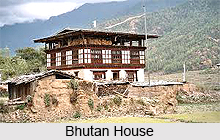 Bhutan House is an estate located in Kalimpong of West Bengal. The administrative headquarters of Bhutan Royal family in Bengal during the rule of British East India Company, this palace is now a symbol of India- Bhutan amity.
Bhutan House is an estate located in Kalimpong of West Bengal. The administrative headquarters of Bhutan Royal family in Bengal during the rule of British East India Company, this palace is now a symbol of India- Bhutan amity.
Location of Bhutan House
Bhutan House was located in Kalimpong, the estate is on Rishi Road, leaving town, between the 10th and 12th miles, just before its fork. The property has fencing and a driveway toward the stone double-storied Victorian-style complex. The landscaped lawns feature a small stupa containing the ashes of Ayi Thubten Wangmo and a white chorten commemorating the late Rani Chuni. Bhutan House overlooks the Relli River below a deep valley.
History of Bhutan House
The land that was to become Bhutan House was ceded from Bhutan to British East India Company in India in 1865 at the conclusion the Bhutan War and as a condition of the Treaty of Sinchula. The land became a subdivision of Darjeeling of West Bengal in 1916, and became part of a hill station. In 1910, Sikkim Political Officer and Tibetologist Sir Charles Alfred Bell engaged Bhutan and signed the Treaty of Punakha and other agreements that had the effect of assigning land in Motithang (Thimphu) and a hill station between Chukha and Thimphu to the British, assigning a portion of Kalimpong to Bhutan, and doubling the per annum subsidy from Britain to Bhutan. Bhutan House itself was reportedly constructed by the Dorjis especially to host the Thirteenth Dalai Lama. The grounds were consecrated by Chogley Yeshey Ngodrup on his return from a pilgrimage to Bodh Gaya. The powerful Dorji family became prominent through their ties to the Wangchuck family.
Architecture of Bhutan House
The interior of Bhutan House is of dark wood. The first floor of Bhutan House contains a sitting room for guests and the dining room. Upstairs are the bedrooms and family altar room. The room of the late Rani Chuni is kept as originally furnished with Bhutanese chodems (carved tables), woven materials, books, and other artefacts. In total, the main house contains over a dozen rooms, including a long hall on each floor. The detached kitchen is also two-storied, connected to the main structure by a small bridge. A lhakhang (Buddhist temple) is also located on the premises.
Owning of Bhutan House
Bhutan House was owned by the Dorji family of Bhutan. It is the home of Queen Grandmother Ashi Kesang Choden Wangchuck, the grandmother of the current Bhutanese king, Druk Gyalpo Jigme Khesar Namgyal Wangchuck.
Function of Bhutan House
Bhutan House is the conventional administrative Dzong for southern Bhutan, and also functioned as the administrative centre for the whole of western Bhutan during the modern kingdom`s early years of consolidation. Bhutan House represented the relationship between Bhutan and British India, and is a modern symbol of Bhutan-India relations.



















